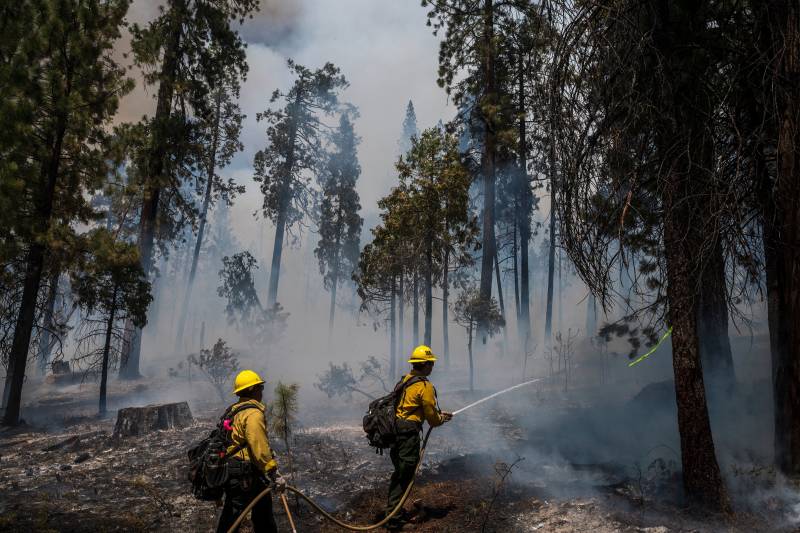Indeed, other old-growth sequoia groves in recent years were not so fortunate.
Native American tribes have long cultivated and continue to champion intentional fire practices to reduce fuels. This ”good fire” along with mechanical and other forest thinning practices are vital tools to help avoid disastrous wildfires, fire ecologists say. That’s because these intentional blazes reduce combustible ”fuel loads” amassed over a century-long policy that prioritized putting out most every wildfire.
Climate change threatens giant trees
Human-caused climate change is only worsening the danger from these built-up fuels, experts say, as it’s driving more severe drought and higher temperatures and contributing to increasingly volatile weather.
The Washburn Fire is driven by dry, built-up forest fuel. But when the blaze swept into Mariposa Grove, the biggest and best known of the park’s three old-growth sequoia clusters, it ran smack into the area of the most recent prescribed fire, slowing its advance and ferocity.
Once it hit that area, “the fire intensity decreased dramatically, rate of spread decreased, and firefighters were able to rapidly engage and start immediately putting in hand line and hose lays and kind of steer the fire around the grove,” ecologist Dickman says.
Fire crews also set up large sprinkler systems, removed smaller trees that could help spread the fire and cleared away forest debris to protect the grove.
But the “good fire” was perhaps the biggest factor. Dickman uses a doughnut analogy. The Mariposa Grove and immediate surrounding area is the doughnut hole, where they’ve concentrated their prescribed fire program for decades. But the area on the outer edges of the doughnut, he says, hasn’t burned in well over 100 to 130 years.
So it was striking how just beyond the grove area, in the doughy part of the “doughnut,” if you will, the fuels were far greater and the fire behavior far more intense, fast-spreading and volatile.
“The flame lengths we saw in the interior of the [Washburn] fire were dozens of feet, if not hundreds of feet” in the air, he says. It was so hot that branches were getting tossed far into the air and one nearly hit aircraft working the fire.
“That’s a lot of heat to put branches into the air. Firefighters can’t really engage when, you know, there’s 125 tons of fuel on fire,” Dickman says. “It’s way, way, way too hot.”
Old-growth sequoias are among the most fire-resilient and fire-adapted trees on Earth. They’re built to withstand fire and need it to reproduce. But today’s blazes are often bigger, burn hotter, and move faster due to a warming Earth and those fuel loads from that history of wildfire suppression.
“The fires they’ve evolved to withstand are very, very different than the fires of today,” Dickman says.
Sequoias need fire, just not too much
Old-growth sequoias’ thick bark and towering canopies high above the forest floor all help protect them from wildfire. And they rely on low-intensity wildfire to reproduce as heat opens their cones and spreads their seeds across the forest floor below to start the life cycle anew.
But the current “high-severity fire” reality is putting California’s sequoias under increasing threat. Since 2015, a series of crippling wildfires, including the deadly Camp Fire, have battered the state, destroying homes, businesses, lives and scores of old-growth trees. In the last two years alone, fire has killed off nearly 20% of all mature giant sequoias.
The successful protection of Mariposa Grove is a striking example and potential case study, experts say, of the power of consistent intentional fire.
In contrast, thousands of large sequoias were killed in 2020’s Castle Fire in Sequoia National Forest and in blazes in other parts of the state, including the KNP Complex fire and the Windy Fire. Some of those areas had a history of prescribed fires to reduce forest fuel. But the difference is in those areas it was not done as often or as widespread and consistently as in the Mariposa Grove area, Dickman says.
“Those groves [in the Castle fire] are kind of deep in wilderness. There’s not very good access. It’s very difficult to get fire on the ground … from a straight logistics standpoint,” he says.
If there’s a silver lining from this fire, Dickman says, it’s that federal, state and nongovernmental organizations are working more closely than ever sharing information, lessons learned as well as research tools and techniques on intentional fire and how to help reduce the threat of catastrophic wildfire and to preserve these spectacular trees.
“We’re all working together to try to do what we can to do more of the actions that we know we need to do to protect giant sequoias in the future.”

